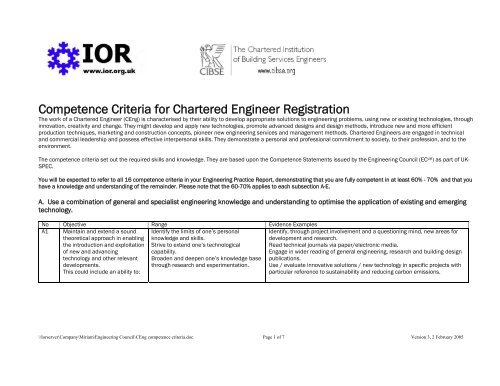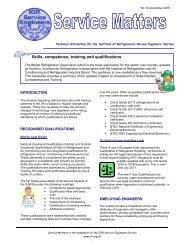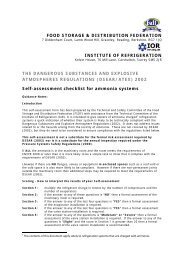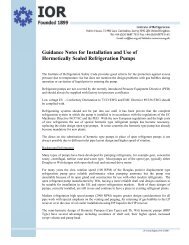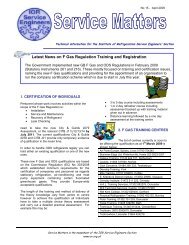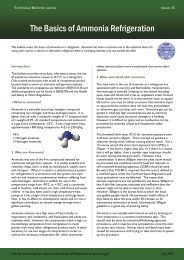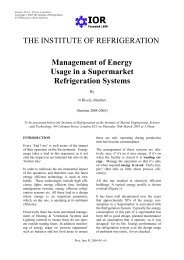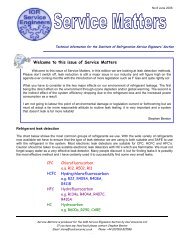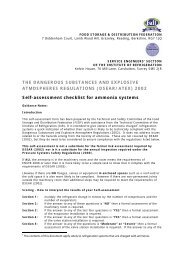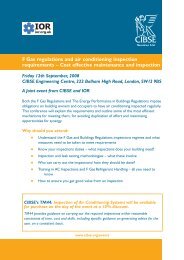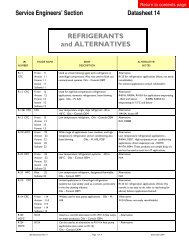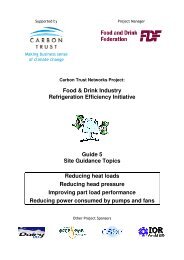Criteria for competency
Criteria for competency
Criteria for competency
You also want an ePaper? Increase the reach of your titles
YUMPU automatically turns print PDFs into web optimized ePapers that Google loves.
Competence <strong>Criteria</strong> <strong>for</strong> Chartered Engineer Registration<br />
The work of a Chartered Engineer (CEng) is characterised by their ability to develop appropriate solutions to engineering problems, using new or existing technologies, through<br />
innovation, creativity and change. They might develop and apply new technologies, promote advanced designs and design methods, introduce new and more efficient<br />
production techniques, marketing and construction concepts, pioneer new engineering services and management methods. Chartered Engineers are engaged in technical<br />
and commercial leadership and possess effective interpersonal skills. They demonstrate a personal and professional commitment to society, to their profession, and to the<br />
environment.<br />
The competence criteria set out the required skills and knowledge. They are based upon the Competence Statements issued by the Engineering Council (EC UK ) as part of UK-<br />
SPEC.<br />
You will be expected to refer to all 16 competence criteria in your Engineering Practice Report, demonstrating that you are fully competent in at least 60% - 70% and that you<br />
have a knowledge and understanding of the remainder. Please note that the 60-70% applies to each subsection A-E.<br />
A. Use a combination of general and specialist engineering knowledge and understanding to optimise the application of existing and emerging<br />
technology.<br />
No Objective Range Evidence Examples<br />
A1 Maintain and extend a sound<br />
theoretical approach in enabling<br />
the introduction and exploitation<br />
of new and advancing<br />
technology and other relevant<br />
developments.<br />
This could include an ability to:<br />
Identify the limits of one’s personal<br />
knowledge and skills.<br />
Strive to extend one’s technological<br />
capability.<br />
Broaden and deepen one’s knowledge base<br />
through research and experimentation.<br />
Identify, through project involvement and a questioning mind, new areas <strong>for</strong><br />
development and research.<br />
Read technical journals via paper/electronic media.<br />
Engage in wider reading of general engineering, research and building design<br />
publications.<br />
Use / evaluate innovative solutions / new technology in specific projects with<br />
particular reference to sustainability and reducing carbon emissions.<br />
\\Iorserver\Company\Miriam\Engineering Council\CEng competence criteria.doc Page 1 of 7 Version 3, 2 February 2005
No Objective Range Evidence Examples<br />
A2 Engage in the creative and<br />
innovative development of<br />
engineering technology and<br />
continuous improvement<br />
systems.<br />
This could include an ability to:<br />
Establish users’ needs.<br />
Assess marketing needs and contribute to<br />
marketing strategies.<br />
Identify constraints and exploit<br />
opportunities <strong>for</strong> the development and<br />
transfer of technology within one’s chosen<br />
field.<br />
Promote new applications when<br />
appropriate.<br />
Secure the necessary intellectual property<br />
rights.<br />
Develop and evaluate continuous<br />
improvement systems.<br />
Participate in / contribute to multi-disciplinary project teams with other<br />
professionals including clients.<br />
Evaluate proposals and plan specific tasks using contemporary schemes and<br />
solutions.<br />
Read publications of other relevant professional institutions.<br />
Critically compare your own and others’ work<br />
Implement innovative technologies paying regard to sustainability and<br />
reducing carbon emissions.<br />
Evaluate completed projects to establish whether objectives were achieved<br />
and consolidate lessons learned.<br />
Take account of the commercial value of your and others’ innovative work and<br />
ideas.<br />
B. Apply appropriate theoretical and practical methods to the analysis and solution of engineering problems.<br />
No Objective Range Evidence Examples<br />
B1 Identify potential projects and<br />
opportunities.<br />
This could include an ability to:<br />
Explore the territory within one’s<br />
responsibility <strong>for</strong> new opportunities.<br />
Review the potential <strong>for</strong> enhancing<br />
engineering products, processes, systems<br />
and services.<br />
Use one’s knowledge of the employer’s<br />
position to assess the viability of<br />
opportunities.<br />
Investigate the business of your employers and understand the company<br />
objectives and business plan.<br />
Participate in activities, discussions, peer group reviews to enhance<br />
knowledge and understanding.<br />
Participate in proposals and presentations and contribute to technology<br />
transfers, investigative thinking and critical evolution.<br />
B2<br />
Conduct appropriate research,<br />
and undertake design and<br />
development of engineering<br />
solutions.<br />
This could include an ability to:<br />
Identify and agree appropriate research<br />
methodologies.<br />
Assemble the necessary resources.<br />
Carry out the necessary tests.<br />
Collect, analyse and evaluate the relevant<br />
data.<br />
Draft, present and agree design<br />
recommendations.<br />
Undertake engineering design.<br />
Take part as team/individual in early client contact e.g.<br />
meetings/presentations, initial proposals and analysis.<br />
Select, use and evaluate software packages.<br />
Integrate manual and computerised design techniques to achieve practical<br />
and innovative solutions.<br />
Establish and agree basis of design including e.g. cost plan, deliverables and<br />
programme <strong>for</strong> implementation.<br />
Engage with others to obtain specialist input including product design, testing,<br />
models, mock-ups and research.<br />
Prepare reports to include e.g. option studies, whole-life per<strong>for</strong>mance<br />
costings, drawing designs and other documentation to solve problems and<br />
meet objectives.<br />
\\Iorserver\Company\Miriam\Engineering Council\CEng competence criteria.doc Page 2 of 7 Version 3, 2 February 2005
No Objective Range Evidence Examples<br />
B3 Implement design solutions, and<br />
evaluate their effectiveness.<br />
This could include an ability to:<br />
Ensure that the application of the design<br />
results in the appropriate practical outcome.<br />
Identify the required cost, quality, safety,<br />
reliability, appearance, fitness <strong>for</strong> purpose<br />
and environmental impact of the outcome.<br />
Determine the criteria <strong>for</strong> evaluating the<br />
design solutions.<br />
Evaluate the outcome against the original<br />
specification.<br />
Feed back the results so as to improve<br />
future design solutions.<br />
Work (through discussions/secondment/placement) with manufacturers and<br />
installers and understand/evaluate their contribution to the design process.<br />
Read manufacturers’ literature and test data to establish understanding of<br />
product development, manufacture and application, and identify any<br />
limitations that might apply.<br />
Initiate a post occupancy review as an assessment tool.<br />
Consult with peers to seek their views of your interpretations. Establish<br />
benchmarks with similar projects as an evaluation strategy.<br />
Update budgets, make comparisons and evaluate differences. Conduct Value<br />
Engineering exercises.<br />
Evaluate results against original targets and assumptions .<br />
C. Provide technical and commercial leadership.<br />
No Objective Range Evidence Examples<br />
C1 Plan <strong>for</strong> effective project<br />
implementation.<br />
This could include an ability to:<br />
Identify the factors affecting the project<br />
implementation.<br />
Lead on preparing and agreeing<br />
implementation plans and method<br />
statements.<br />
Ensure that the necessary resources are<br />
secured and brief the project team.<br />
Negotiate the necessary contractual<br />
arrangements with other stakeholders<br />
(client, subcontractors, suppliers, etc.).<br />
Play a key role in a major project involving other professionals and disciplines.<br />
Engage in site meetings, conduct of negotiations, meeting deadlines.<br />
Undertake risk analysis and be aware of the CDM Regulations and other<br />
statutory regulations.<br />
Develop an implementation programme, identifying significant dates.<br />
Estimate any resource required.<br />
Answer client queries, respond to changes/requests, advise on cost/benefits<br />
ratios, propose alternative solutions.<br />
Embrace current and proposed legislation including working towards zero<br />
carbon emissions and the use of sustainable materials.<br />
Prepare tender and/or bid documentation.<br />
\\Iorserver\Company\Miriam\Engineering Council\CEng competence criteria.doc Page 3 of 7 Version 3, 2 February 2005
No Objective Range Evidence Examples<br />
C2 Plan, budget, organise, direct<br />
and control tasks, people and<br />
resources.<br />
This could include an ability to:<br />
Set up appropriate management systems<br />
Agree quality standards, programme and<br />
budget.<br />
Organise and lead work teams, coordinating<br />
project activities.<br />
Ensure that variations from quality<br />
standards, programme and budgets are<br />
identified, and that corrective action is<br />
taken.<br />
Gather and evaluate feedback, and<br />
recommend improvements.<br />
Take part in tender analysis.<br />
Use/compile criteria/checklists to ensure fair judgement between different<br />
tenderers.<br />
Observe and report inconsistencies/misleading presentation of in<strong>for</strong>mation in<br />
tenders received.<br />
Advise and report, with recommendations, on competing tenders.<br />
Obtain and use standard <strong>for</strong>ms.<br />
Read and refer to relevant legislation, cases , in<strong>for</strong>mation resources e.g.,<br />
periodicals, Times Law Report and participate in contract law training<br />
courses/seminars.<br />
Contribute to preparing documentation <strong>for</strong> claims or disputes.<br />
Prepare spreadsheets of costings, resource required and monitor these<br />
against agreed programmes.<br />
Evaluate any proposed changes and make recommendations/issue<br />
instructions accordingly.<br />
C3<br />
Lead teams and develop staff to<br />
meet changing technical and<br />
managerial needs.<br />
This could include an ability to:<br />
Agree objectives and work plans with teams<br />
and individuals.<br />
Identify team and individual needs, and<br />
plan <strong>for</strong> their development.<br />
Lead and support team and individual<br />
development.<br />
Assess team and individual per<strong>for</strong>mance,<br />
and provide feedback.<br />
Have responsible experience of supervising others.<br />
Draft job/ person specifications, job adverts.<br />
Contribute to selecting team members, coach, train and develop team spirit,<br />
resolve disputes.<br />
Participate in/ develop appraisal systems.<br />
Exhibit leadership skills, e.g. in managing a crisis.<br />
Have responsibility in Quality Circles or similar.<br />
Read books and articles on quality theory, TQM and current case studies.<br />
Analyse the distinctive features of QA in the building services engineering<br />
environment.<br />
Undertake a cost/benefit analysis of the QA scheme operated by your<br />
organisation.<br />
Participate in damage limitation/ reparation when QA becomes compromised.<br />
Participate in Investors in People Scheme or similar.<br />
\\Iorserver\Company\Miriam\Engineering Council\CEng competence criteria.doc Page 4 of 7 Version 3, 2 February 2005
No Objective Range Evidence Examples<br />
C4 Bring about continuous<br />
improvement through quality<br />
management.<br />
This could include an ability to:<br />
Promote quality throughout the organisation<br />
and its customer and supplier networks.<br />
Develop and maintain operations to meet<br />
quality standards.<br />
Direct project evaluation and propose<br />
recommendations <strong>for</strong> improvement.<br />
Establish and participate in company quality schemes.<br />
Consult with and make presentations to peer group on e.g. projects<br />
undertaken, project development, solutions reached.<br />
Organise or participate in quality groups.<br />
Evaluate your own work and be critical as to its content and outcome.<br />
Set key per<strong>for</strong>mance indicators (KPI)<br />
Encourage manufacturers, contractors and other professionals to evaluate<br />
their progress/inputs/outputs at strategic stages.<br />
Engage in a process of continuous evaluation against preset targets, e.g. <strong>for</strong><br />
use of resources, cash flow, drawing/documentation production, installation<br />
progress.<br />
D. Demonstrate effective interpersonal skills.<br />
No Objective Range Evidence Examples<br />
D1<br />
Communicate with others at all<br />
levels.<br />
This could include an ability to:<br />
Contribute to, chair and record meetings<br />
and discussions.<br />
Prepare letters, documents and reports.<br />
Exchange in<strong>for</strong>mation and provide advice to<br />
technical and non-technical colleagues.<br />
Identify opportunities/constraints inherent in different site settings. Prepare<br />
agendas and minutes <strong>for</strong> site meetings, identify/ develop/ establish <strong>for</strong>mal/<br />
in<strong>for</strong>mal communication channels between site personnel.<br />
Negotiate on variations and instructions.<br />
Prepare / handle handover/closing documentation.<br />
Participate in meetings, produce records and documentation.<br />
Explain process, technical rationales and constraints as necessary to clients<br />
and colleagues. e.g. Factory Acceptance Tests, witness testing on site, role of<br />
regulatory authorities<br />
\\Iorserver\Company\Miriam\Engineering Council\CEng competence criteria.doc Page 5 of 7 Version 3, 2 February 2005
No Objective Range Evidence Examples<br />
D2<br />
Present and discuss proposals.<br />
This could include an ability to:<br />
Prepare and deliver appropriate<br />
presentations.<br />
Lead and sustain debates with audiences.<br />
Feed the results back to improve the<br />
proposals.<br />
Take part in meetings with prospective clients.<br />
Analyse client specifications.<br />
Obtain involvement of different departments in preparing final package.<br />
Prepare bids.<br />
Evaluate final tender, appreciate particular tendering practices/ cultural<br />
differences of particular types of client, e.g. local authority clients,<br />
private/public sector clients, overseas clients, PFI, Partnering.<br />
Develop practical skills in presentations (relevant software, flip charts, overheads)<br />
to small and large groups having researched and prepared material.<br />
Attend seminars, critically evaluate their usefulness, ask questions and<br />
debate answers.<br />
D3<br />
Demonstrate personal and<br />
social skills.<br />
This could include an ability to:<br />
Know and manage one’s own emotions,<br />
strengths and weaknesses.<br />
Be aware of the needs and concerns of<br />
others.<br />
Be confident and flexible in dealing with<br />
new and changing interpersonal situations.<br />
Identify, agree and work towards collective<br />
goals.<br />
Resolve conflicts and create, maintain and<br />
enhance productive working relationships.<br />
Select and use appropriate communications styles <strong>for</strong> the range of<br />
professional situations, e.g. skim/ scan/ study, write <strong>for</strong> notes, memos, <strong>for</strong>mal<br />
letter, academic, reports, minutes.<br />
Exhibit listening skills.<br />
Make oral presentation to small / large <strong>for</strong>mal / in<strong>for</strong>mal groups. Exhibit<br />
interpersonal skills e.g. assertiveness, negotiation, flexibility, dealing with<br />
conflict.<br />
Select appropriate communication modes / approaches <strong>for</strong> different<br />
situations e.g. sell, explain, reprimand.<br />
Communicate in a <strong>for</strong>eign language.<br />
Effectively manage your own time.<br />
E. Demonstrate a personal commitment to professional standards, recognising one’s obligations to society, the profession and the environment.<br />
No Objective Range Evidence Examples<br />
E1 Comply with relevant codes of<br />
conduct.<br />
This could include an ability to:<br />
Comply with the rules of professional<br />
conduct of one’s own professional body.<br />
Work constructively within all relevant<br />
legislation, including social and employment<br />
legislation.<br />
Examine digest and abide by the relevant Codes of Conduct. Exercise all<br />
reasonable professional skill and care<br />
Give due regard as appropriate to the Engineering Council (ECUK) Guidelines.<br />
Maintain a working knowledge of current and impending legislation, standards<br />
and Codes of Practice that will influence, guide and regulate your work.<br />
Maintain professional competence by research, reading and participating in<br />
the activities of the Institute.<br />
\\Iorserver\Company\Miriam\Engineering Council\CEng competence criteria.doc Page 6 of 7 Version 3, 2 February 2005
No Objective Range Evidence Examples<br />
E2 Manage and apply safe systems<br />
of work.<br />
This could include an ability to:<br />
Identify and take responsibility <strong>for</strong> one’s<br />
own obligations <strong>for</strong> health, safety and<br />
welfare issues.<br />
Ensure that systems satisfy HS&W<br />
requirements.<br />
Develop and implement appropriate hazard<br />
identification and risk management<br />
systems.<br />
Manage, evaluate and improve these<br />
systems.<br />
Be aware of your employers’ health and safety policy and practice as they<br />
relate to your personal circumstances and to your responsibility <strong>for</strong> others.<br />
Provide in<strong>for</strong>mation as required <strong>for</strong> the Health and Safety plan <strong>for</strong> projects and<br />
to comply with the Construction (Design & Management) Regulations (CDM).<br />
Be familiar with safe systems of work, method statements <strong>for</strong> the execution of<br />
work and permits to work systems.<br />
E3<br />
E4<br />
Undertake engineering activities<br />
in a way that contributes to<br />
sustainable development.<br />
This could include an ability to:<br />
Carry out continuing professional<br />
development necessary to<br />
maintain and enhance<br />
competence in one’s area of<br />
practice.<br />
This could include an ability to:<br />
Operate and act responsibly, taking account<br />
of the need to progress environmental,<br />
social and economic outcomes<br />
simultaneously.<br />
Use imagination, creativity and innovation to<br />
provide products and services which<br />
maintain and enhance the quality of the<br />
environment and community, and meet<br />
financial objectives.<br />
Understand and encourage stakeholder<br />
involvement.<br />
undertake reviews of one’s development<br />
needs<br />
prepare action plans to meet personal and<br />
organisational objectives<br />
Carry out planned (and unplanned) CPD<br />
activities<br />
Maintain evidence of competence<br />
development<br />
Evaluate CPD outcomes against the action<br />
plans<br />
Assist others with their own CPD.<br />
Actively promote the profile and implementation of engineering solutions and<br />
designs that embrace the principles of sustainability in materials and energy<br />
sources.<br />
Actively engage in the process of reducing carbon emissions by reducing<br />
energy requirements using prudent design techniques and innovation.<br />
Observe good practice with regard to aspects of sustainability in the conduct<br />
of your own work.<br />
Help clients to embrace sound environmental principles by providing them<br />
with whole life per<strong>for</strong>mance in<strong>for</strong>mation<br />
Be involved with Professional Institution activities.<br />
Read professional journals, attend employer, and other development<br />
seminars.<br />
Plan own immediate medium and long term CPD.<br />
Help others plan their CPD.<br />
Establish links with local training/education providers.<br />
Advise others on building services engineering careers.<br />
Mentor, assist and guide the professional development of others Access<br />
in<strong>for</strong>mation sources <strong>for</strong> learning opportunities.<br />
Exercise skills transfer between professional and personal life.<br />
\\Iorserver\Company\Miriam\Engineering Council\CEng competence criteria.doc Page 7 of 7 Version 3, 2 February 2005


